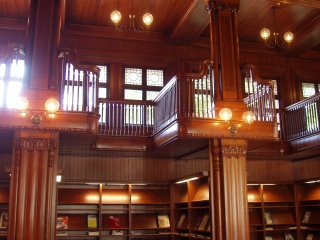
When I moved to Boston three years I told myself that this city was a place to learn about old buildings and old building traditions. Beyond the general feeling of approval or disappointment I have when in a classical building, I feel I lack the vocabulary necessary to really speak about a building whose success lies most in its subtle use of languages I don’t speak, or speak only haltingly and with effort.
H.H. Richardson’s Crane Memorial Library in Quincy has been a place I have intended to visit since first reading of it several years ago. I’ve even been there by chance on a bike ride with friends, but a temporary closure kept me on its outside, enjoying the stone and unable to see its rich wood interior. Today’s warm weather got me on my bike and there again.
Today I spent an hour or so inside, the building meticulously restored and used as the library’s magazine reading room—a surprisingly quiet part of the library on a Saturday afternoon. I drew the plan, understood its organization and found patterns in the wooden ornament.
Being in the library felt like an exercise for me. I wasn’t moved by the space, but appreciated its craftsmanship. I felt able to understand some of Richardson’s decisions. I’m still wondering about others, wondering which ones fall comfortably within the range of accepted gothic revival designs and which ones show Richardson heading somewhere different. I can’t help but look for abstraction and am drawn to the library’s stranger moments for this reason: it’s understated and off-center entrance; the informally asymmetrical roofline that brings light into the building from different heights on its different sides. I look at classical buildings as a critic without his glasses: I’m able to appreciate the structure and forms of the building, but cant’ really see its details—at least not with the appreciative eye that I would like someday to develop. It’s hard not to be awed by the detail, cowed by the knowledge that were I asked to design a wooden stair railing or column, I would not have access to this tradition.
Still, even seeing this building with foggy modern eyes, I can see that it is more interesting than the city today. Boston may have been, must have been, at it’s most vibrant and exciting at the turn of the century. A brief period of wonderful, heroic, exploration into concrete blew apart pieces of the city and introduced a rough scale to its streets. They provide a contrast that I love, but are already too far from the present. Middle children who live in the shadow of the city’s historic core—talented, awkward, and showy in a city that doesn’t quite know what to make of them. And we keep building. But we haven’t said anything really interesting. There’s so little that can speak to either Boston’s history or its iconoclasm (the city’s concrete megastructures are the companions to the giant infrastructural projects that have always kept Boston a construction site).
And yet I think there may be interesting stories being told about this city. There are the string of artists that come through Cambridge, often affiliated with MIT, that combine art and urbanism. There’s an exhibition in Cambridge that I’m looking forward to seeing(Urban Networks at Art Interactive in Central Square). An art organization in the Fort Point Channel has built itself a home surrounded by highways and unoccupied loft buildings. I’ve only passed it at night, and I think its time to see what’s happening inside. It may be here rather than the towers rising Downtown or in the Greenway that may someday wrap through the city, that the most interesting stories about the city are being created.